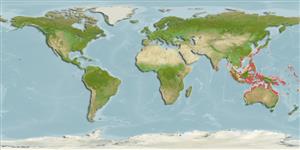Environment: milieu / climate zone / depth range / distribution range
Οικολογία
Θαλασσινό(ά); Υφάλμυρο Υφαλόφιλο(α); εύρος βάθους 1 - 12 m (Ref. 90102). Tropical
Indo-West Pacific: Indo-Australian Archipelago.
Μέγεθος / Βάρος / Age
Maturity: Lm ? range ? - ? cm
Max length : 134 cm TL αρσενικό/απροσδιόριστο; (Ref. 2334); common length : 40.0 cm TL αρσενικό/απροσδιόριστο; (Ref. 9801)
Short description
Κλείδες προσδιορισμού | Μορφολογία | Μορφομετρία
Ραχιαίες άκανθες (συνολικά) : 1; Μαλακές ραχιαίες ακτίνες (συνολικά) : 104 - 115; Εδρικές άκανθες: 0; Μαλακές εδρικές ακτίνες: 90 - 100. Differs from Paraplotosus butleri in having a shorter dorsal fin and shorter nasal barbels, rounded pectoral fin shape, fewer upper procurrent caudal fin rays, and fewer gill rakers. Differs from P. muelleri in having a shorter dorsal fin and smaller eye (Ref. 31103). Color highly variable, ranging from pale grey or yellowish brown to dark brown, nearly blackish, sometimes with pronounced dark mottling; generally whitish on belly and ventral part of head; fins brown to blackish, frequently darker than body (Ref. 31103).
In tropical areas, inhabits clear and turbid coral reefs; usually found in areas with mixed sand, weed, and coral areas (Ref. 31103). May be seen resting on sand bottoms under ledges or around coral bommies (Ref. 31103). Adults solitarily or in small groups. Presumably nocturnal (Ref. 31103). Feeds on gastropod mollusks and crustaceans (Ref. 31103). Spines associated with anterior fins have potent venom (Ref. 9801).
Life cycle and mating behavior
Maturities | Αναπαραγωγή | Spawnings | Egg(s) | Fecundities | Προνύμφες
Allen, G.R., 1998. A review of the marine catfish genus Paraplotosus (Plotosidae) with the description of a new species from north-western Australia. Raf. Bull. Zool. 46(1):123-134. (Ref. 31103)
IUCN Red List Status (Ref. 130435)
Human uses
αλιεία: περιορισμένης εμπορικότητας
Εργαλεία
Special reports
Download XML
Διαδικτυακές πηγές
Estimates based on models
Preferred temperature (Ref.
123201): 24.2 - 29.3, mean 28.5 °C (based on 2310 cells).
Phylogenetic diversity index (Ref.
82804): PD
50 = 0.6250 [Uniqueness, from 0.5 = low to 2.0 = high].
Bayesian length-weight: a=0.00457 (0.00199 - 0.01049), b=3.07 (2.86 - 3.28), in cm total length, based on LWR estimates for this (Sub)family-body shape (Ref.
93245).
Τροφικό Επίπεδο (Ref.
69278): 3.4 ±0.54 se; based on food items.
Ελαστικότητα (Ref.
120179): Χαμηλό, ελάχιστος χρόνος για διπλασιασμό πληθυσμού 4,5 - 14 έτη (Preliminary K or Fecundity.).
Fishing Vulnerability (Ref.
59153): Very high vulnerability (80 of 100).
Nutrients (Ref.
124155): Calcium = 26.6 [11.5, 53.2] mg/100g; Iron = 0.437 [0.248, 0.789] mg/100g; Protein = 17.4 [15.5, 19.6] %; Omega3 = 0.0738 [, ] g/100g; Selenium = 37.8 [19.2, 80.7] μg/100g; VitaminA = 42.4 [14.3, 124.5] μg/100g; Zinc = 1.12 [0.77, 1.59] mg/100g (wet weight); based on
nutrient studies.
